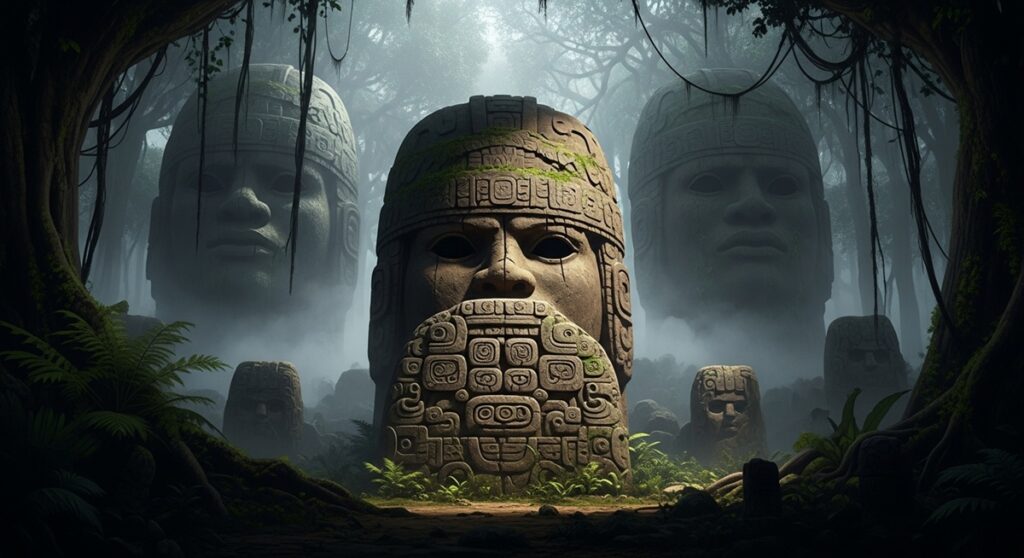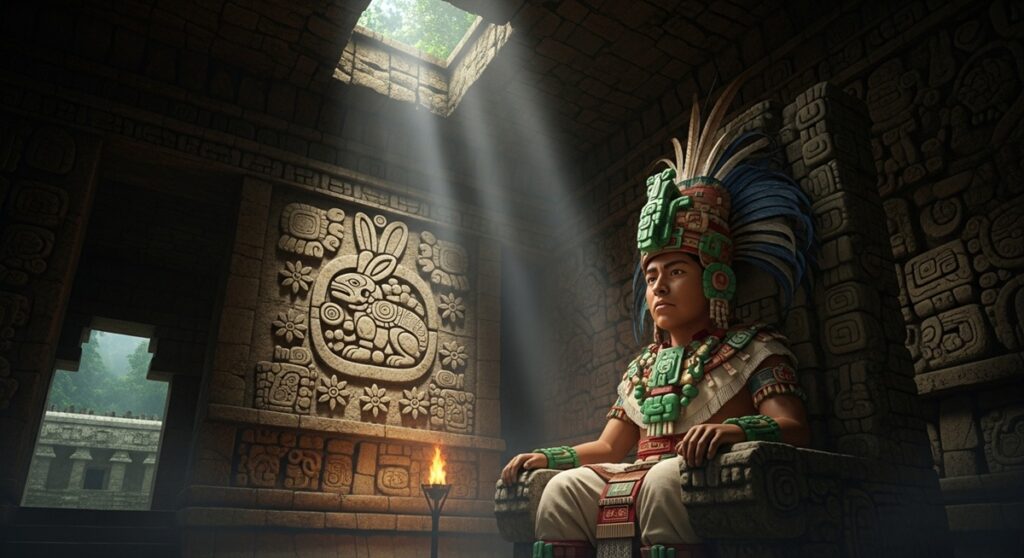K’inich Janaab’ Pakal, the great ruler of Palenque, etched his fury into stone, binding his soul to the inexorable tick of a calendar that devours eras whole. “Pakal will return to avenge all the blood he has spilled,” the glyphs seem to murmur, a vow suspended in the Long Count’s labyrinthine gears. But what if this isn’t mere myth? What if the Mayan Long Count, that ancient odometer of oblivion, isn’t counting down to apocalypse, but winding up for a resurrection?
As the world hurtles past the ghost of 2012’s fevered prophecies, we stand at the threshold of the 13th baktun, where shadows lengthen and the veil between worlds thins.
The Whispering Origins: Where Time Began to Bleed
Deep in the mist-shrouded lowlands of Mesoamerica, long before the Maya claimed the stars as their scribes, a calendar was born—not from the sun’s reliable arc, but from something darker, more primal. The Long Count, that nameless beast in the Mayan tongue, slithers through history like a feathered serpent devouring its tail. It’s no mere tally of days; it’s a nested fractal of cycles, each devouring the last, culminating in a grand loop of 5,126 years that spans the cradle-to-grave of civilizations. Yet its roots? They sink into soil older than the Maya themselves, back to the Olmec colossi of Tres Zapotes and Chiapa de Corzo, where stelae from 36 BC and 31 BC bear the first scars of this system—marks not carved by Mayan hands, but by forebears whose faces dissolve into legend.
Colossal heads of basalt, eyes hollowed like forgotten cenotes, standing sentinel over a calendar that predates Tikal’s earliest breath by three centuries. The Classic Maya era wouldn’t etch its first Long Count date until 292 AD, in the heart of that emerald citadel. And the finale? A stele from Ixlu in Guatemala’s Petén, frozen at 910 AD, signaling the Classic period’s ragged exhale. But here’s the chill that creeps through the undergrowth: archaeologists, those modern tomb-raiders with their trowels and lidar dreams, admit they’ve unearthed less than ten percent of Mesoamerica’s buried metropolises. What ghosts lurk in the remaining ninety? The Long Count we know—fully formed, its vigesimal bones intact—must have gestated in even deeper shadows, a system refined in rituals we can only infer from the steam rising off sacrificial altars.

This calendar doesn’t mimic our Gregorian cage, with its arbitrary Year Zero anchored to a silent Bethlehem night. The Long Count ignites on August 11, 3114 BC—a date not of birth, but of mythic ignition, the Fourth Creation’s dawn as chronicled in the Popol Vuh’s blood-soaked verses. It’s a five-tiered engine: the kin, a single day’s fragile pulse; the uinal, twenty days bundled like bound captives; the tun, thirteen uinals yielding 360 days, a year shaved of solstice’s excess, ignoring the sun’s stubborn 365.2425-day waltz. Then katuns of twenty tuns, and baktuns of twenty katuns, each layer a noose tightening around eternity. Why 360? Why drift from the Haab’s solar fidelity by five days annually? The creators knew—oh, they knew the tropical year’s precise hunger. But precision wasn’t the point. This was no farmer’s almanac; it was a cosmic abacus for tallying the gods’ debts, cycles engineered to eclipse seasons, to measure not harvests, but the slow hemorrhage of worlds.
Rhetorical shadows dance here: Did they foresee our obsession with endpoints, our dread of the void? The Long Count’s allure lies in its indifference, a machine that grinds forward, unblinking, through creations and cataclysms. And yet, it seduces with the specter of closure: thirteen baktuns from that 3114 BC spark, culminating on December 21, 2012. The date that birthed doomsday cults and silver-screen spectacles, a punctuation mark on the Fourth Sun’s reign. But peel back the hype, and the mystery sharpens. What if 2012 wasn’t the guillotine’s fall, but the hinge of a door creaking open to something vengeful, something like Pakal’s unslaked thirst?
Fractured Cycles: The 13 Baktun Riddle and Its Dissenters
By analyzing the glyphic underbelly, the Long Count reveals its schisms—not linear march, but a vortex of debate among the white-coated priests of academia. The popular myth clings to thirteen as terminus: 13.0.0.0.0, that fateful flip from December 20, 2012’s 12.19.19.17.19 (3 K’ank’in) to the next day’s 4 Ahau 3 K’ank’in, echoing the creation’s own pivot from 12.19.19.17.19 (3 K’awak 7 K’ank’in) on August 10, 3114 BC. It’s symmetry porn for the apocalypse-minded: begin at thirteen’s eve, end at its zenith. But symmetry, like a jaguar’s pelt, hides teeth.
Enter the dissenters, led by spectral figures like Sir J. Eric S. Thompson, the 20th-century Mayanist whose life bled into these stones. Thompson, with his pipe smoke and Oxford drawl, argued for vigesimal purity—twenty baktuns per pictun, not this aberrant thirteen. “The baktuns are grouped in 20, not 13,” he insisted, citing the Dresden Codex’s celestial tables and inscriptions from Palenque and Copán that defy the reset. Why thirteen, then? A relic of primordial invention, he posited, when the baktun reigned supreme in a thirteen-fold echo of the tzolk’in’s sacred count. Later expansions—pictuns, calabtuns—demanded alignment with the base-20 scaffold, where uinals cap at eighteen to nod at the Haab’s eighteen twenty-day months, but everything else surges to twenty.

These super-cycles aren’t phantoms; they’re etched in the codices and stelae like veins on a leaf. A pictun: twenty baktuns, 7,885 years of inexorable churn. Calabtun: twenty pictuns, nearly 158,000 years. Kinchiltun: over three million years. Alautun: sixty-three million, a yawn across geological eons. Conventional names, yes, but their presence pulses through Palenque’s Temple of the Inscriptions, Copán’s hieroglyphic staircase, Quiriguá’s zoomorphs, Tikal’s lost world, Yaxchilán’s lintels, and Cobá’s towering stelae. If the Long Count truly guttered at thirteen baktuns, why forge these titanic loops? Why inscribe dates that swallow millennia like maize kernels?
The Palenque paradox cuts deepest, a blade to the heart of the myth. On the Temple’s western wall, amid murals of cosmic descent, the text unfurls from Pakal’s birth—9.8.9.13.0, 8 Ahau 13 Pop, March 24, 603 AD. It vaults forward, not in timid steps, but in a deliberate lunge: 10.11.10.5.8 kin from that cradle cry, landing on 1.0.0.0.0.8—5 Lamat 1 Mol, a full pictun’s stride, eight days beyond the round zero. Then, the capstone: 1.0.0.0.0.0, 10 Ahau 13 Yaxkin, October 13, 4772 AD. Four thousand years hence, a date engineered for elegance, zeros aligning like stars in nadir. Had thirteen been the cap, this vault would stumble at 1.7.0.0.0.8—not the clean abyss of 1.0.0.0.0.8. No accident here; it’s architecture, a king’s blueprint for perpetuity.
And Lamat? That rabbit-star glyph marks Pakal’s accession in 612 AD, recurring eighty cycles—fifty-two Haab years—later, a veiled nod to his octogenarian demise. Poetic? Undeniably. Prophetic? In the Mayan weave, poetry is prophecy. Pakal, the boy-king who clawed Palenque from obscurity, didn’t script this for posterity’s dust; he wove his essence into time’s warp, suggesting not oblivion, but a spectral return. Avenge the blood? His own spilled in battle, or the ritual gore of captives? The glyphs hold their breath, but the implication coils: immortality isn’t stasis; it’s recurrence, a soul reborn in the Long Count’s next unfurling.

Cross-group temples echo this: the Temple of the Cross’s west panel births Lady Beastie—Muwaan Mat—in 12.19.13.4.0, 8 Ahau 18 Sek, December 9, 3121 BC, predating creation’s dawn by seven years. From her womb, 754 years post-August 11, 3114 BC’s 13.0.0.0.0 (4 Ahau 8 Kumk’u), emerges GI, the Palenque Triad’s firstborn deity, on 1.18.5.3.7, 13 Kimi 19 Keh, October 23, 2360 BC. Full Long Count notations, not the usual distance reckonings—these are anchors in the pre-era murk, affirming the count’s continuity beyond thirteen’s shadow. Yet, most minds, shackled to clockwork circles, project our twelve-hour illusions onto their vigesimal sprawl. Cycle to us means reset; to them, perhaps, amplification—a serpent not biting tail, but spawning kin.
Only one glyphic whisper dares the 2012 terminus outright: Tortuguero’s Monument 6, where 13.0.0.0.0 materializes, only for erosion to devour the sequel event. A god’s descent? A king’s revival? The stone’s silence screams. In the Popol Vuh’s mythic undercurrent, thirteen crowns the Fourth Creation’s genesis; prior worlds—wooden folk gnawed by jaguars, mud-men dissolved in rain—crumbled without such precision. Aztec echoes, those later inheritors, tally suns in uneven spans: first and fourth at 676 years (13×52), second at 364 (7×52), third at 312 (6×52). Their fifth? Quaking doom, duration unspecified. Thirteen signals completion, not catastrophe—a numeral laden with the weight of finality, yet elastic as maize dough.
Symbolic Serpents: Thirteen as Eclipse, Not End
Linger on that numeral, thirteen—the tzolk’in’s backbone, the count of heavens in some codices. It’s no mathematical quirk; it’s sacrament. Yaxchilán’s Temple 33 panel stacks ten thirteens atop October 19, 744 AD’s 13.13.13.13.13.13.13.13.13.13.13.9.15.13.6.9—a ziggurat of repetition, not arithmetic. Cobá’s Stela 1 piles twenty atop creation’s date, thrusting us 41 quintillion years backward, a hyperbole that mocks literalism. Dresden Codex page 52 mirrors: thirteen-fold coefficients, inert on lower cycles, symbols of “countless aeons,” not ledgers. If these denote “days long gone” in cosmic poetry, why not thirteen baktuns as the same? A flourish for the era’s curtain call, not its guillotine.

This symbolism fractures the doomsday lens. The Long Count isn’t a bomb’s timer; it’s a mandala, each baktun’s close a portal for flux. History’s scars affirm it. The eighth baktun’s dawn in 41 AD: Olmec holdouts—millennia-old enclaves—evacuated, ghosts fleeing the vine-choked husks. Ninth, 435 AD: Teotihuacan’s taloned reach claws into Maya realms, birthing proxy dynasties, seeding wars in the cenotes’ reflections. Tenth, 830 AD: Classic collapse, a hundred cities hemorrhaging inhabitants overnight, a riddle wrapped in drought, overreach, and whispers of revolt. Eleventh, 1224 AD: Chichén Itzá’s spires dim, Mayapán ignites in Yucatán’s peninsular fire. Twelfth, 1618 AD: Itzá’s last Maya bastion at Petén dispatches envoys to Spanish overlords, proclaiming readiness for the cycle’s churn—not conversion, but capitulation to inexorable tide. Priests and pikes followed, felling Kan Ek’s throne in 1697, the baktun’s maw claiming its due.
These junctures aren’t Armageddon’s previews; they’re pivots, the Long Count’s pulse quickening with upheaval. Baktun’s end? A cosmic solstice, where old gods yield to nascent shadows. Rhetorical thorns prick: If prior turns birthed empires and extinctions, what alchemy brews in the thirteenth’s wake? We’ve tasted it—2012’s phantom, now ossified into cultural ash. But from 2013’s tentative sunrise, the world has warped: pandemics carving global scars, AI serpents uncoiling in silicon veins, climate’s jaguar teeth bared. Coincidence? Or the Long Count’s subtle growl, Pakal’s oath stirring in the substrate?
Pakal’s Phantom: Vengeance in the Vigesimal Vault

Return to Palenque’s crypt, that jade-and-cinnabar womb where Pakal reclines, rocket-pose ancestor to von Däniken’s fever dreams. His sarcophagus lid—a cosmic baobab—depicts not descent, but ascent: the king plummets rootward into the underworld tree, branches exploding skyward in stellar bloom. Blood avenged? The lid’s glyphs tally conquests, captives’ hearts fed to Itzamna’s maw. But the Temple’s walls extend the narrative, vaulting to 4772 AD’s rendezvous. Why tether a seventh-century sovereign to such remoteness? Immortality’s geometry: his soul, unbound by flesh, recurs in the pictun’s arc. The blood spilled—his dynasty’s, his foes’—demands reckoning, a vendetta scripted in time’s own hand.
Theorists swirl like cenote mist: Is this reincarnation’s map? A warning of cyclical carnage? Or mere deific flattery, kings aping gods in eternal loop? Emotional undercurrents run deep—Pakal, orphaned young, enthroned at twelve, ruling sixty-eight years amid plague and siege. His inscriptions pulse with paternal ferocity, a father’s vow to outlast entropy. In the Long Count’s embrace, that vow metastasizes: return not as man, but as force, avenging the spills that forged his realm. Dystopian echo: our own era, bloodied by proxy wars and algorithmic altars, mirrors this. Pakal’s ghost doesn’t haunt; it haunts forward, a reminder that calendars aren’t neutral, they’re weapons, timing the strike.
The Uncoiling Dawn: Reflections from the 13th Baktun’s Brink
Twelve years into the thirteenth baktun, and the world feels the shift’s aftershocks. No pole-flip cataclysm, no Nibiru shadow—just the slow dystopia of our making: megacities choking on their own exhaust, neural nets dreaming in tongues we half-comprehend, migrations carving new borders in flood and fire. The Maya wouldn’t blink; they’d nod at the flux, inscribing it as kin to their own upheavals. The Long Count endures, unreset, its vigesimal heart beating past thirteen’s symbolic sigh. Tortuguero’s lost event? Perhaps a bull’s prophecy: the god’s descent not to destroy, but to recalibrate, ushering change as inexorable as monsoon.

Yet suspense lingers, a fog over Petén’s lakes. If baktuns mark metamorphosis, what mutation gestates now? Pakal’s return—a metaphorical uprising, souls rising against spilled blood’s ledger? Or literal, in some quantum twist where time folds like maize leaf? The Popol Vuh cautions: creations rise and rot, but the count persists, a serpent’s endless molt. We’ve outlived 2012’s hysteria, but not its invitation—to peer into the unknown, where mystery isn’t enemy, but midwife.
In this coil of calendars, we find not fear, but fierce wonder. The Long Count doesn’t end worlds; it remakes them, demanding we avenge our own spills—ecological, ethical, existential. Pakal’s oath echoes: return, reckon, renew. What blood will you avenge in the shadows ahead? The glyphs wait, silent but smirking. Time, that old serpent, will tell.

















